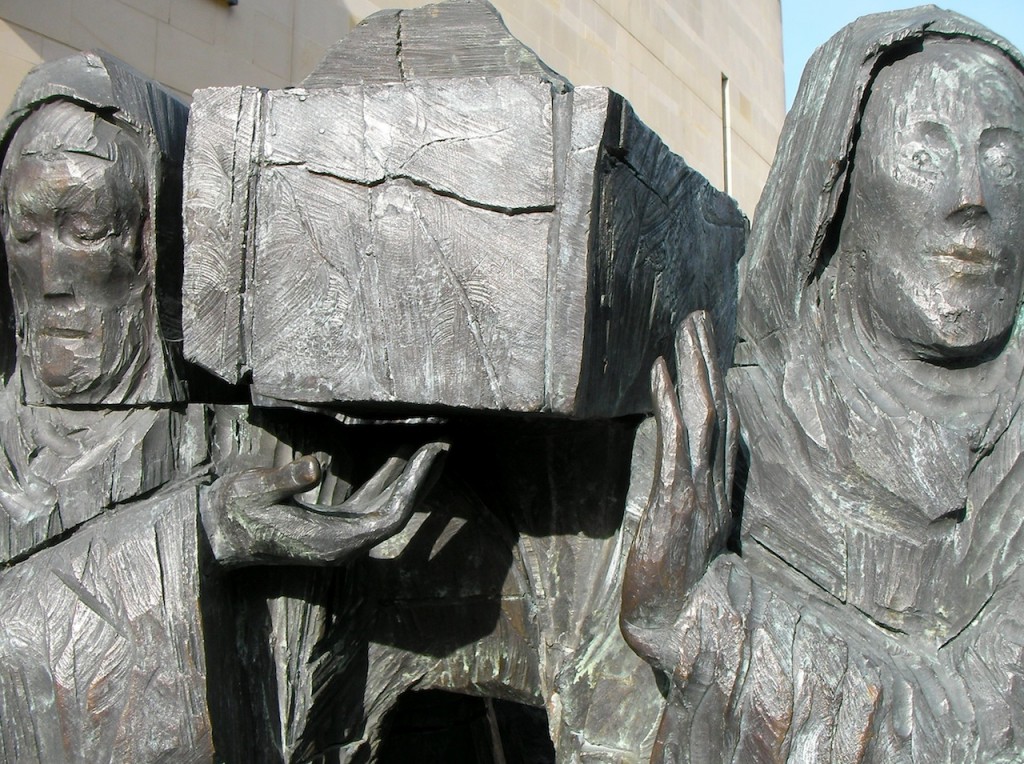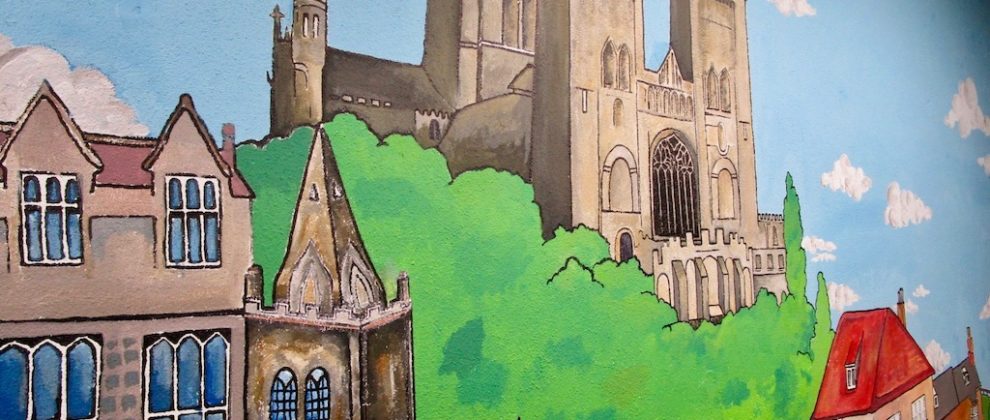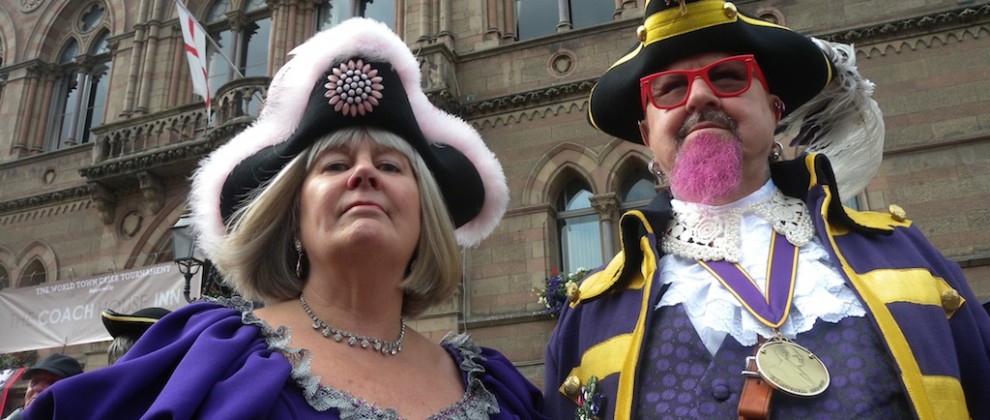
* A lot of my stories these days are close to home and this is a good example of finding a story on my own doorstep.
As ever, follow me on Twitter, or subscribe to the RSS, for weekly updates from my travel-writing archive in the months to come.
The locals know him affectionately as ‘Cuddy’.
He was a teenage shepherd boy who saw a holy vision, went on to join a strict monastic order and was elevated to sainthood after his death in 687AD.
His body then spent almost 200 peripatetic years criss-crossing northern Britain in search of a resting place. Even today, his presence permeates every nook and cranny of the historic city where he was ultimately entombed.
We even still toast his longevity with pints of local ale bearing his name. His contemporary, The Venerable Bede, may be better known internationally for his work as a chronicler and scholar but without St Cuthbert, there would be no Durham.
“To modern eyes, Cuthbert seems a bit serious and worthy, while Bede is the all rounder who would bat for England in a cricket match,” smiles the Durham-based Blue Badge Guide Jan Williams.
“While modern Durham is an amalgamation of many stories, we can trace all of those stories back to Cuddy.”
Resting place
Cuthbert’s body was eventually brought to medieval Dun Holme, modern-day Durham, in 995AD.
The cathedral is the third church on the site and replaced a Saxon stone church and was founded as a shrine to the saint on the well-protected natural peninsula formed by the River Wear. Prior to that, small settlements existed near the peninsula, but not on it, with a clutch of Roman encampments around the fringes.
The main settlement was little more than a clearing in a woodland glade. But pilgrims soon followed to worship at Cuthbert’s shrine and Durham’s place in history was henceforth assured.
Pilgrims still come to Durham to pay their respects to Cuddy but, these days, the city that grew up around him has become one of the key heritage sites in northeast England.
This year marks 25 years since Unesco first designated Durham Cathedral and Castle a World Heritage Site – it was among the first sites recognised in the UK. In 2008 the boundaries of the site were revised to include the historic buildings sandwiched between the two iconic buildings on Palace Green.
Visitor centre
A brand-new World Heritage Visitor Centre officially opens its doors this month to act as a gateway to the expanded Durham World Heritage Site.
“Heritage is a huge asset but you have to do something useful with it,” says Seif El Rashidi, World Heritage Site Coordinator.
“We want to present a less fragmented vision of the site and act as a springboard for new projects, working with students from the university.”
Seif moved to Durham three years ago from the al-Darb al-Ahmar medieval heritage project in Cairo. “Before I arrived,” he smiles, “the only thing I knew about Durham was the view of the castle and cathedral from the train to Edinburgh.”
The visitor centre, converted from a former almshouse, features three key sections: a hands-on illustration of what makes a Unesco World Heritage Site; a film explaining Durham’s place on the prestigious Unseco list, along side the likes of the Taj Mahal and Robin Island; and a guide to the hidden-gem discoveries to be found around the site.
Across the manicured green is the Palace Green Library, which unveiled its refurbished Wolfson Gallery in January this year. With a permanent collection of books, documents and objects from the extensive university collection, it’s also home to temporary exhibitions.
Highlights of the collection include a sculpture of a Nubian servant girl from 1360BC, Robert Hooke’s Micrographia, prints of creatures and natural structures as seen through a microscope, from 1665, and Benedictine Gradual, a 11th-century cathedral service book from just after the Norman Conquest.
New galleries and visitor facilities will be added over the next year.
Hidden gems
But before following the well-trodden pilgrim trail, heading uphill from the bustling Market Place to the tranquil Palace Green, it’s worth taking time to explore some of the lesser-known attractions of the former medieval hilltop town.
Just before Franwellgate Bridge, the first river crossing from 1120, Moatside Lane marks the original pilgrim’s route to the cathedral shrine.
The lane is one of Durham’s historic vennels, narrow-width passageways, which traditionally provided a short cut through the squalor of the cholera-riddled medieval centre. Today they’re packed with cosy little cafes and boutiques.
The Market Place, still home to the Victorian Indoor Market and the Town Hall, looks refreshed following the recent completion of the Heart of the City regeneration project to open up the public space for events.
This summer, BRASS: Durham International Festivals runs July 1-17 July while Streets Of, a summer festival of street art and performance will be held from August 27-29.
The Town Hall may be tucked away behind a nondescript façade, but it’s worth venturing inside for a glimpse of the Victorian Main Hall.
A stained-glass window of Edward III, astride a white stallion, against a backdrop of medieval Durham dominates the room. A series of plaques down the left-hand wall offers a roll call of the prestigious names to have been conferred the Honorary Freedom of the City.
Among them are Archbishop Desmond Tutu, who addressed the crowd from the Town Hall’s balcony in 1987, and the author Bill Bryson, currently outgoing Chancellor of Durham University, who has been a regular visitor since 2009.
Saintly signs
Exploring the city outside the World Heritage site, reminders of Cuddy’s legacy are all around.
The Journey, a bronze-cast sculpture of followers bearing his coffin outside the tourist information centre, a statue of him lost in contemplation in the garden of the small but compelling Durham Heritage Centre.
Some of the public artworks lining the steep riverbanks, gazing up to the castle and cathedral looming majestically above, also celebrate his influence.
This view, the sweeping panorama from the Millhouse across the weir by Prebends Bridge, is the iconic view of Durham that has inspired writers and artists over the centuries.
JMW Turner, fascinated by the quality of the light in northern Britain, came to paint the view in watercolour, while Sir Walter Scott was suitably moved to pen the a few stanzas:
“Grey towers of Durham, yet well I love thy mixed and massive piles. Half church of God, half castle ‘gainst the Scots.”
The dramatic denouement to the Durham tour, however, is the steep walk up from Kingsgate Bridge to the World Heritage Site anchored between the cathedral and the castle.
The latter, in particular, is crucial to another important aspect of Durham’s history.
Work started on Durham’s motte-and-bailey castle in 1072 and the grand structure was to become home to the Prince Bishops. It was William the Conqueror who created the role of the quasi-monarchical bishop as a safe pair of hands to represent his regional affairs between London and Scotland.
Their power and influence was concentrated between the River Tyne to the north and the River Tees to the south. The subsequent appointees, often flamboyant characters with larger-than-life personal histories to match their status, enjoyed over 800 year of power and influence over their fiefdom.
The powers of the Prince Bishops were diminished by the dissolution of the monasteries in 1539 and the commonwealth period in the 1650s.
The last Prince Bishop, William van Mildert, donated the castle to the founding of the university in 1832, just before his death and the final absorption of powers back into the crown.
His legacy was to create the third oldest university in England after Oxford and Cambridge, an august institution that today supports over 12,000 students in a collegiate system and brings a huge sense of vitality to the small, rather quant, 40,000-strong city.
The castle visit is now based around an official tour, while the Cathedral remains both free to visit and the jewel in Durham’s heritage crown. Its complex engineering feats of Romanesque stone vaults, huge pillars and early Gothic pointed arches in the East End are enough to stun most visitors into a hushed, reverential silence.
In the crypt
Cuddy rests, finally, in peace in the feretory (the place of the bones is the literal translation), a plain slab marked Cuthbertus, the only epitaph.
Beade Venerabilis lies in the Galilee Chapel, having been moved to Durham in the 12th century from Jarrow, east of Newcastle.
Outside the cathedral, students dash to lectures, tour groups explore the historic buildings around Palace Green and children try hunt in the treasure box, one of the more hands-on attractions in the new Visitor Centre.
Durham may be a city rich in medieval heritage, but it’s not a cobweb-strewn museum. It feels alive.
“I admire the fact that Durham is not too precious about its heritage,” says Jan Williams.
“Despite its historic riches, it’s still a working town, not preserved in aspic.”
* This story was first published in Discover Britain Magazine in 2011. Liked this? Try Pilgrimage Trails on the Llyn Peninsula.
And post your comments below.



